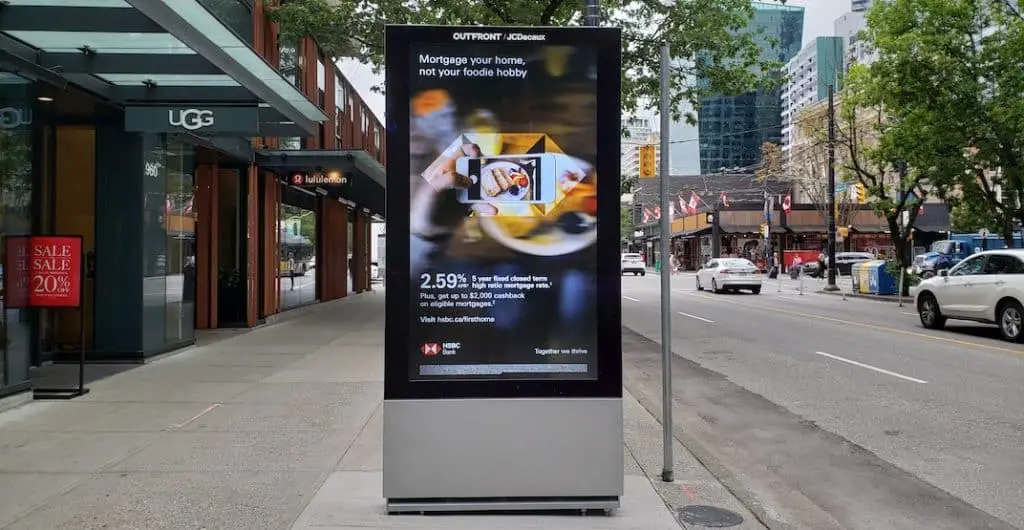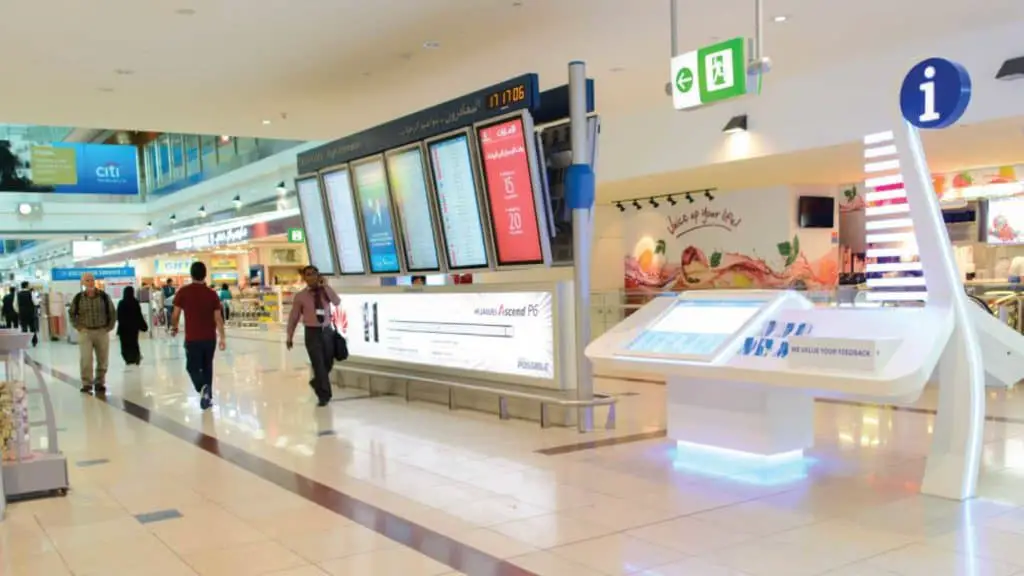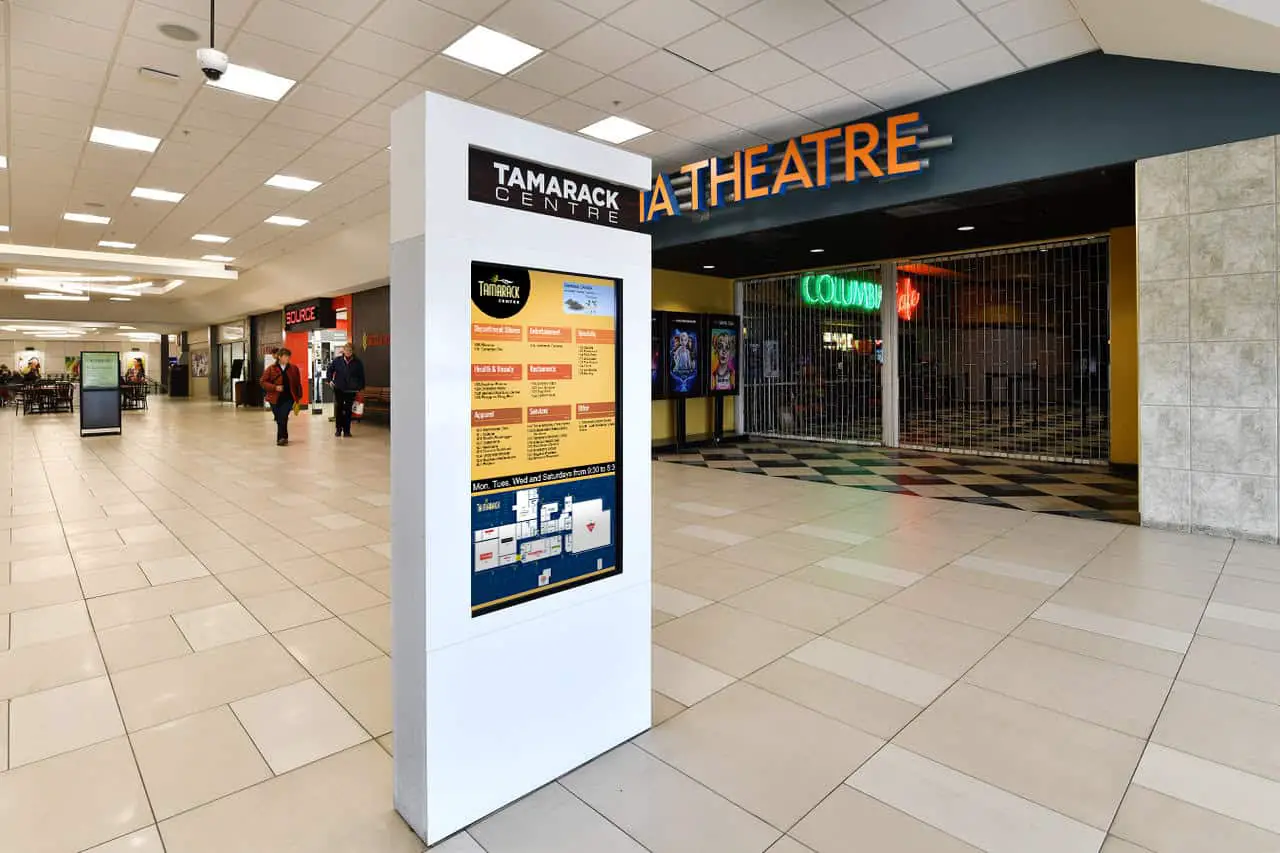This post contains affiliate links.
Great digital signage software is the key to managing your network of signage devices effectively and at a low cost. Digital signage businesses that choose their solutions in this space wisely have a major leg up on their competition. But, many wonder how exactly this software makes everything work.
Digital signage software is the suite of tools you use to manage your digital signage network. This management covers all aspects of the business, including content, analytics, network management, advertising, and maintenance.
This software will become especially important as the number of digital screens rapidly increases. Over 67% of digital signage users predict that out-of-home advertising will increase in the near future, while 80% of brands that have leveraged digital signage in their outreach strategy have recorded substantial increases in their sales since rolling it out.
Having the best solution to meet these needs is critical to the success of any communications and marketing business that handles digital signage.
Why Digital Signage Software Matters
Digital signage software covers a range of roles in the management of your digital signage network. Your signage network should be able to deliver maximum impact for your business.
This software is how you will update the content your signage will display, manage your marketing campaigns, and oversee the operations of your digital signage ads. It is not overstating things to say that your digital signage software plays an outsized role in the success of your marketing goals.
Today, the software through which you manage your digital signage network covers far more ground than ever before and includes powerful tools to optimize the efficiency and effectiveness of your digital signage marketing.
Digital signage software has expanded into roles that a few years ago wouldn’t have even been on the radar for many marketing and communications businesses, and those roles are only growing in number. Here are a few types of digital signage software.
Management of Content and Signage Devices
Of course, we’ll start with the obvious role of digital signage software, which is delivering control over the actual content and settings on the digital signage itself.
In its infancy, digital signage required each sign to be manually updated by a technician on-site, using a direct hookup to a computer that would transfer the necessary content to the device. This process was both cumbersome and time-consuming.
Most companies did not have the resources to send an employee to every sign whenever they needed to deliver new content or to fix a problem. It soon became apparent that digital signage would not be able to work at scale without a change.
Now, we have web interfaces through which you can update content and manage settings across all your digital signage without ever having to set foot in the locations in which they are installed.
This software operates as a content management system or CMS. Often this CMS is developed in-house and is proprietary to the digital signage network, but just as often that network might make use of a third-party solution.
The choice of which approach to take would depend on several factors, such as the cost of developing your own versus paying a vendor for a license to use theirs, and how much control you feel you need over your network.
A strong candidate for a digital signage CMS will allow you to manage all the operations of your digital signage content remotely, including these aspects:
- Maintenance
- Development
- Troubleshooting
- Settings management
- Access control
- Quality assurance
- Analytics
- Monitoring and diagnostics
Any CMS you work with should make things more efficient for your team, not less. If you find yourself spending more time fixing problems with content management because of interface design or having to visit signs in-person to resolve issues, view these as red flags that an audit of your CMS may be in order, and potentially consider alternatives.
Software as a Supply-Side Platform
One way to manage your digital signage advertising is to open it up as a service to your potential customers to drive ad sales. This approach involves allowing your customers to work with your inventory of digital signs directly. It is a good way to reach a broader set of clients than you might normally work with if you keep tight control over your digital signage.
This is not turning over control of your signage to your customers, but it is making it available as a service on the supply side in a more direct way to your customers.
One thing to look for when shopping for a supply-side platform is that it is tailored to the out-of-home marketing clients you are seeking. It should also allow you to manage the kinds of ads that are displayed on your signage.
You needn’t look very hard to find embarrassing incidents regarding controversial ads appearing in public spaces to understand why this might be important. You should be allowing as broad a range of ad types as you can without compromising your brand in a way that distracts from your messaging.
Software for Serving Ads to Your Digital Signs

If you are selling ad space on your digital signs, you will want a way to serve up those ads in a manageable way. This means using an ad server to direct the advertising content to the appropriate devices at the proper time.
Ad servers play an important role in this area of your digital marketing and advertising network, and you may have arrangements through multiple channels for advertising deals. Managing these channels can become cumbersome across several solutions.
You may want to consider an ad server that allows you to manage these ads in one place, regardless of the source. This will make ad management far easier when you have several sources for your ad content.
It is also important to consider how you sell your ads, whether using traditional methods or through a program of open exchange or proprietary marketplace. Ad servers can distinguish between these two ad spaces and manage them differently based on need, provided they have the features to support it.
Ad servers should be vetted to ensure they can scale to your network of screens your organization manages. It should be able to schedule ad delivery in accordance with your campaigns. Finally, you probably want to be able to integrate it with your existing digital signage software, such as your content management system.
Software for Creating Content
The content displayed on digital signs must come from somewhere. Most of the time this is going to be content created using conventional graphic design software. Some examples of this would be Adobe Photoshop, Microsoft PowerPoint, and Canva. Content design tools for digital signs specifically also exist, such as Signage Creator.
Some content management software for digital signage will have native tools for content creation. Often these will take the form of drag-and-drop interfaces that use widgets to tie in certain information, such as weather reporting, social media, online videos (such as YouTube or Vimeo), news, or traffic alerts.
These tools will also allow for controlling features such as background images, font characteristics, image cropping, and slide transitions for your content. These tools should be evaluated against third-party options to see which options provide the features for your content creation needs.
The design of your content is crucial to getting your message across. The design should take into account the emotions and overall sense that a digital page needs to convey, and things like font, color, and layout play a large part in successful messaging.
Content design is a skill that demands a well-developed knowledge of design practices, communication skills, and artistic vision. If you want to achieve maximum impact, it’s advisable to hire professional designers in-house or on contract to create your content.
What Features Should My Digital Signage Software Have?

When considering digital signage software, you should be keeping in mind how you want to use it and what features you want it to have. The most obvious feature required is the ability to manage your digital signage devices remotely.
Other features you should consider are:
- The ability to create playlists of content,
- Scheduling content playback for your target audience (for instance, if targeting commuters, scheduling content for playback during high traffic periods),
- Assigning devices into groups for which you can assign the same content, settings, and access control,
- A way to bring in programmatic ad revenue through a broad range of potential clients.
Other factors that are important for a digital signage software solution are monitoring of individual devices. This is especially important for large screen networks that may be spread across a wide geographic area. Sometimes this network can even span multiple countries or continents. It is critical to keep downtime for devices to a minimum.
Although some systems rely on customer feedback to alert them of an inoperable or otherwise problematic digital signage device, falling back on this approach can leave a device vulnerable to long periods of downtime before it’s reported. So, having a monitoring system as part of your digital signage software can be a huge efficiency booster.
In addition, your device management toolkit should allow you to:
- Reboot a digital signage system remotely,
- Deploy updates to internal systems such as firmware and operating systems,
- Send you alerts automatically if the system is unresponsive,
- Notify you about the status of your signage network,
- Display snapshots of signage content.
Display Content Dynamically
Another useful feature for digital signage software is displaying dynamic content. By dynamic, in this context, we’re referring to content that changes as the information it refers to changes.
So, for instance, a widget that displays information about the weather will periodically poll a weather service to pull in the latest weather and update its display data. A news widget could pull down the 5 most-frequently referenced news stories on Twitter. Social media information could be presented that changes as new Tweets or Facebook posts are submitted on various topics.
Other types of dynamic content that such software could leverage would be things like video content from YouTube, multiple choice quizzes, a local events calendar, local traffic and transit updates, and emergency announcements.
Control and Vetting of Content
It is a really good idea to make sure that your digital signage management toolkit includes features that allow for vetting of content before it is displayed on any device. This might take the form of a holding queue where submitted content undergoes a review process and gets signed off on by one or more reviewers before it is allowed to pass through.
The importance of vetting your content cannot be overstated as displaying inappropriate content, even unintentionally, can seriously damage your brand and reputation, as well as that of your clients. Some content may not fit with the mission of your organization or convey confusing or misleading information.
While it’s understandable to want to avoid drifting into censorship too heavily, having clear guidelines around what content is appropriate for your signage network will help avoid unpleasant public relations crises.
Collect and Use Analytics Data
Measuring the impact your digital signage network is having for your business and your client’s marketing goals has historically been challenging to gather. However, analytics tools have been making their way into digital signage software and begun providing useful and accurate metrics.
Many digital signs now have cameras that can use face recognition algorithms to determine if someone is looking at the screen, and proximity sensors to determine when someone is within a certain distance of the device. There are even devices that can determine the characteristics of people looking at it and identify demographics by gender, age, or emotional condition.
Digital signs that have touchscreens for viewer interaction can provide metrics on where on the screen users are engaged and direct decisions on how to design more impactful user interfaces. These devices can also be configured to deliver personalized content based on who is interacting with it, expanding the role of these screens to even more engagement and marketing possibilities.
How Does Digital Signage Software Work?
Digital signage management software operates through a client-server communication of some type. Usually, this involves there either being a server on the premises running the management software, or the software is offered through a cloud-based service (otherwise known as software-as-a-service of SAAS).
Interacting with this software is done through a client running on one or more PCs in your organization. The client could be a web-based client or an application that is installed on the PC.
The Work Flow
The software users will then issue commands through the client to the server, which then passes these instructions onto the digital signage devices themselves.
The screens themselves will be connected to a digital content player, a small computer that has the job of sending the digital content to the screen. These players will be running their own software that talks to the server about the state of the device and listens for instructions and content from the server to display.
The digital players can pass back information about the condition of the device itself, including any current settings, access control, activity logs, maintenance logs, and trouble or distress states that require attention. They can also collect and communicate analytics about how the devices are being used, which can be useful when the device is interactive, such as a digital map in a shopping mall or airport.
Communication Between the Elements
The communication between the client, server, and devices in this scenario should always be encrypted to protect the system from anyone listening in and seeking to collect passwords or other sensitive information. It is also very important that access control is limited to those who require it to manage the devices.
This access control can vary across roles, so these roles should be well-defined and only allow the level of access required for the responsibilities of each. Finally, the user account credentials for authentication should enforce complexity and require changing regularly, such as every 60 days, to protect against hijacking devices and content.
Options for Digital Signage Software
There are several reliable third-party solutions for managing your digital signage. As we mentioned earlier, depending on the size and availability of resources in your business, you might decide to develop your own software solutions to meet your needs. But here are a few that have been given the thumbs up by reviewers.
Digital signage software will only become more critical as the use of digital signage trends upward. Consider that 40% of retailers and 63% of banks either have rolled out or had plans to roll out digital signage in their locations.
As these numbers continue to rise, the need for efficient management of digital signage will drive innovation in the digital signage software space towards better features and lower costs.
If you have a well-considered plan for your digital signage strategy that includes software solutions that meet your business requirements effectively, you will be well-positioned to capitalize on this upward trend.


